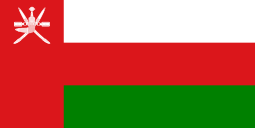Gwadar
Gwadar (Urdu: گوادر) is a port city on the southwestern coast of Balochistan, Pakistan. The city is located on the shores of the Arabian Sea opposite Oman. Gwadar was an overseas possession of Oman from 1783 to 1958.[2] It is about 120 km (75 mi) southwest of Turbat, while the sister port city of Chabahar in Iran's Sistan and Baluchestan Province is about 170 km (110 mi) to the west of Gwadar.
Gwadar گوادر | |
|---|---|
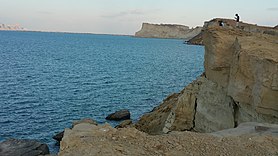 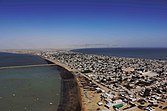 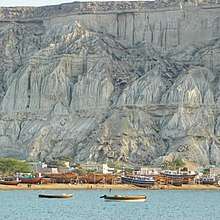 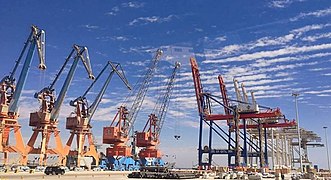  From top, left to right: Blue Lagoon at Gwadar, Gwadar coastline, Gwadar Fishing Basin, Gwadar Port, Gwadar Bay | |
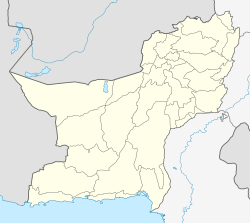 Gwadar 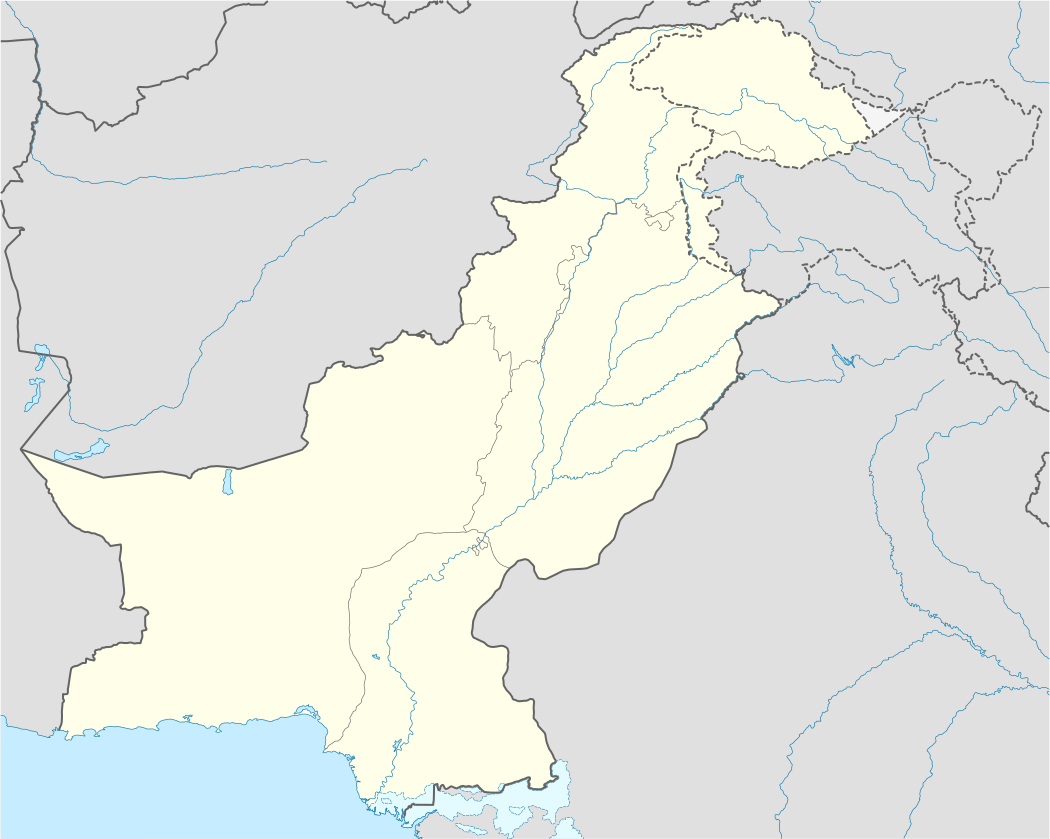 Gwadar | |
| Coordinates: 25°07′35″N 62°19′21″E | |
| Country | |
| Province | |
| District | Gwadar |
| Population | |
| • Total | 90,762 |
| Time zone | UTC+5 (PST) |
| Calling code | 086 |
| Number of towns | 1 |
| Number of Union councils | 5 |
| Website | Gwadar Development Authority – GDA |
For most of its history, Gwadar was a small to medium-sized settlement with an economy largely based on artisanal fishing. The strategic value of its location was first recognized in 1954 when it was identified as a suitable site for a deep water port by the United States Geological Survey at the request of Pakistan while the territory was still under Omani rule.[3] The area's potential to be a major deep water port remained untapped under successive Pakistani governments until 2001, when construction on the first phase of Gwadar Port was initiated.[4] The first phase was inaugurated in 2007 at a total cost of $248 million.[5] The port initially remained underutilized after construction for a variety of reasons, including lack of investment, security concerns, and the Government of Pakistan's failure to transfer land as promised to the port operator, Port of Singapore Authority.[6]
In April 2015, Pakistan and China announced their intention to develop the $46 billion China–Pakistan Economic Corridor (CPEC),[7] which in turn forms part of China's ambitious One Belt, One Road.[8] Gwadar features heavily in CPEC, and is also envisaged to be the link between the One Belt, One Road and Maritime Silk Road project.[9] $1.153 billion worth of infrastructure projects will be invested into the city as part of CPEC,[10] with the aim of linking northern Pakistan and western China to the deep water seaport.[11] The city will also be the site of a floating liquefied natural gas facility that will be built as part of the larger $2.5 billion Gwadar-Nawabshah segment of the Iran–Pakistan gas pipeline project.[12] In addition to investments directly under the aegis of CPEC in Gwadar city, the China Overseas Port Holding Company in June 2016 began construction on the $2 billion Gwadar Special Economic Zone,[13] which is being modelled on the lines of the Special Economic Zones of China.[14] In September 2016 the Gwadar Development Authority published a request for tenders for the preparation of expropriation and resettlement of Old Town Gwadar.[15]
Etymology
The word "Gwadar" is a combination of two Balochi words – Guad meaning Wind and Dar meaning Gateway or door, thus Gwadar means "The Gate of wind".[16]
History
Ancient
The inhabitation of Gwadar, like most areas of Balochistan, appears to be ancient. The area shows inhabitation as early as the Bronze Age with settlements around some of the area's oasis. It is from this settlement pattern that word Makran, the original name of Balochistan, is derived. For a period, it was a region of the Achaemenid Persian Empire. It is believed to have been conquered by the founder of the Persian Empire, Cyrus the Great. The capital of the satrapy of Gedrosia was Pura, which is thought to have been located near the modern Bampūr, in Iranian Balochistan. During the homeward march of Alexander the Great, his admiral, Nearchus, led a fleet along the modern-day Makran coast and recorded that the area was dry, mountainous, and inhabited by the "Ichthyophagoi" (or "fish eaters"), an ancient Greek rendering of the ancient Persian phrase "Mahi khoran," which has itself become the modern word "Makran".[17] After the collapse of Alexander's empire the area was ruled by Seleucus Nicator, one of Alexander's generals. The region then came under Mauryan rule around 303 BCE, after Seleucus made peace with Emperor Chandragupta and ceded the territory to the Mauryans.
Omani rule
| 1783–1958 | |||||||||
 Coat of Arms
| |||||||||
| Status | Omani overseas possession | ||||||||
|---|---|---|---|---|---|---|---|---|---|
| Capital | Gwadar | ||||||||
| Common languages | Balochi Also spoken; Brahui, Arabic, others | ||||||||
| Sultan | |||||||||
• 1783 | Sultan bin Ahmad (first) | ||||||||
• 1932 | Said bin Taimur (last) | ||||||||
| Wali | |||||||||
| History | |||||||||
• Cessation by the Khan of Kalat | 1783 | ||||||||
• Purchase and annexation by Pakistan; | 1958 | ||||||||
| Currency | Omani Rial Pakistani Rupee | ||||||||
| |||||||||
| Today part of | Balochistan, Pakistan | ||||||||
The region remained on the sidelines of history for a millennium until the Arab-Muslim army of Umar captured Makran in AD 643 and over the intervening (and nearly equivalent) amount of time the area was contested by various powers. This was then followed by almost two centuries of local rule by the various Baloch tribes. The city was visited by Ottoman Admiral Seydi Ali Reis in the 1550s and mentioned in his book Mirat ul Memalik (The Mirror of Countries), 1557.[18] According to Seydi Ali Reis, the inhabitants of Gwadar were Baloch and their chief was Malik Jelaleddin, son of Malik Dinar.
In the 15th century the Portuguese conquered parts of India and Oman. They planned to proceed with annexation of the coastal area of Makran. They attacked Gwadar under the leadership of Vasco de Gama, but under the supervision of Commander Mir Ismaheel Baloch, the Portuguese were defeated by the Baloch. A few times the Portuguese looted and set the coastal villages on fire, but they failed to capture Gwadar. Cannons of the Portuguese army were found lying near the Central Jail of Gwadar, heirless. The grave of Mir Ismaheel Baloch is situated near the Mountain of Batal Gwadar, constructed by Mir Ismaheel Baloch himself during life. He died in 873 Hijri.[19] By the end of the 16th century, Mughal Emperor Akbar the Great conquered the city along with all of Balochistan after the Battle of Sehwan. It remained under Mughal control until early 18th century.
In 1783, the Khan of Kalat Mir Noori Naseer Khan Baloch granted suzerainty over Gwadar to Taimur Sultan, the defeated ruler of Muscat.[20] When the sultan subsequently retook Muscat, he was to continue his rule in Gwadar by appointing a wali (or "governor"). This wali was then ordered to subjugate the nearby coastal town of Chabahar (now in Iran). The Gwadar fort was built during Omani rule, whilst telegraph lines were later extended into the town courtesy of the British. In the middle of the 18th century, Mir Noori Naseer Khan Baloch captured Gwadar and its surrounding areas after defeating the Gichki Baloch tribe and included it in the Kalat Khanate. However, realizing that maintaining control of the area will be difficult without the support of the Gichkis, Mir Nasir entered into an agreement with the local Gichki Chief, which allowed the Gichkis to maintain administrative control of the area, in return for furnishing half the collected revenues to Kalat, this arrangement continued till 1783. When Saiad Sultan fell out with his brother, the ruler of Muscat, and asked for help, Mir Noori Naseer Khan handed over Gwadar, as part of his share of revenues, to Saiad Sultan for his maintenance with the understanding that the area be returned to Kalat, when Saiad Sultan acquires the throne. Saiad Sultan ascended to the throne of Muscat in 1797 but never returned Gwadar enclave to Kalat. The ensuing struggle between the heirs of the Sultan and Khan of Kalat for possession of Gwadar, allowed the British to intervene. The British after extracting concessions from the Sultan for the use of the area facilitated Muscat to retain Gwadar. Later on, the British claimed that the area was granted to the Sultan by Mir Nasir, however, local accounts and the declassified documents of that time challenge this claim.[21] From 1863 to 1879 Gwadar was the headquarters of a British Assistant Political Agent. Gwadar was a fortnightly port of call for the British India Steamship Navigation Company's steamers and included a combined Post & Telegraph Office. The Sultan of Oman was the sovereign of Gwadar until negotiations led by Prime Minister of Pakistan Feroz Khan Noon and his wife Viqar-un-Nisa Noon[22] resulted in its transfer to the government of Pakistan in the 1950s.[23]
Pakistan
In 1948, Makran acceded to the newly created Dominion of Pakistan and was made a district — but Gwadar at that time was not included in Makran. In 1958, Gwadar and its surrounding areas were reverted by Oman to Pakistan by the efforts of Prime Minister of Pakistan Feroz Khan Noon and his wife Viqar-un-Nisa Noon.[22] It was given the status of a Tahsil of Makran district. On 1 July 1977, Makran District was upgraded into a division and was divided into three districts of Turbat (Kech since 1994–95), Panjgur and Gwadar.
Gwadar underwent major development from 2002 to 2007. In 2002, Pakistan's National Highway Authority (NHA) began construction of the 653 km-long Makran Coastal Highway linking Gwadar with Karachi via Pasni and Ormara and onwards with the rest of the National Highways of Pakistan, which was completed in 2004. In 2003, the Gwadar Development Authority was established to oversee the planning and development of Gwadar and Gwadar Industrial Estate Development Authority was established to promote industrial activities in mega port city of Gwadar.[24] In 2004, Pakistan's NHA began construction of the 820-km long M8 motorway linking Gwadar with Ratodero in Sindh province via Turbat, Hoshab, Awaran and Khuzdar and onwards with the rest of the Motorways of Pakistan. In 2006, the Gwadar Development Authority conceived, developed and adopted a 50-year Master Plan for Gwadar. In 2007, the Civil Aviation Authority of Pakistan acquired 1,700 ha (4,300 acres) to construct a new greenfield airport, the New Gwadar International Airport 2,400 ha (6,000 acres), at an estimated cost of US$246 million.[25]
Geography
Topography
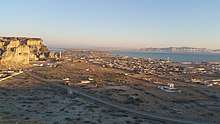

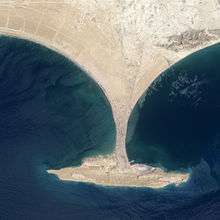
Gwadar is situated on the southwestern Arabian Sea coast of Pakistan in Gwadar District of Balochistan province. Like Ormara further east, Gwadar is situated on a natural hammerhead-shaped tombolo peninsula forming two almost perfect, but naturally curved, semicircular bays on either side. The city is situated on a narrow and sandy 12 km-long (7 mi) isthmus which connects the Pakistani coast to rocky outcroppings in the Arabian sea known as the Gwadar Promontory, or Koh-e-Batil, which reach an elevation of 150 m (480 ft) and extend 11 km (7 mi) east to west with a breadth of 1.5 km (1 mi).[26] The 240 m (800 ft) wide isthmus upon which Gwadar is located separates the two almost perfect semicircular bays from one another. The western bay is known as the Paddi Zirr, and is generally shallow with an average depth of 3.7 m (12 ft), and a maximum depth of 9.1 m (30 ft).[26] To the east of the isthmus is the deepwater Demi Zirr harbor, where the Gwadar Port was built.
The area north of the city and Gwadar Promentory is flat and generally barren. The white clay Koh-e-Mehdi (also known as Jabal-e-Mehdi) is a notable exception, and rises sharply from the plans to the northeast of Gwadar. The Koh-e-Mehdi features a two discernible peaks, with heights of 415 and 419 m (1,360 and 1,375 ft), and is approximately 6 km (4 mi) wide and features sharp cliffs that drop precipitously into the Arabian Sea.[26] Following an earthquake in September 2013 a small island called Zalzala Jazeera ("Earthquake Island") formed approximately 2 km (1.2 mi) off the coast.
Population
The population of the city has risen to approximately 85,000 as of 2014.[27] The population of Gwadar is predominantly Baloch.[28][29]
Climate
Gwadar has a hot desert climate (Köppen BWh), characterised by little precipitation and high variation between summer and winter temperatures. Oceanic influence from the cool currents of the Arabian Sea moderates temperatures, resulting in notably cooler summer temperatures compared to areas inland and cities in the Persian Gulf such as Dubai. The Arabian Sea also moderates winter temperatures, resulting in warmer winter nights as compared to inland areas.
The mean temperature in the hottest month (June) remains between 31 °C and 32 °C. The mean temperature in the coolest month (January) varies from 18 °C to 19 °C. The uniformity of temperature is a unique characteristic of the Makran Coastal region. Occasionally, winds moving down the Balochistan plateau bring brief cold spells, otherwise the winter is pleasant. In Gwadar, winters are shorter than summers. Although Gwadar is situated outside the monsoon belt, it receives light monsoon showers in summer (June–August). However, in winter, Western Disturbance can cause heavy rainfall. Annual rainfall is only 100 mm (3 inches). In June 2010, Gwadar was lashed by Cyclone Phet with record-breaking rains of 372 mm and winds up to 121 km/h (75 mph).
| Climate data for Gwadar, Pakistan | |||||||||||||
|---|---|---|---|---|---|---|---|---|---|---|---|---|---|
| Month | Jan | Feb | Mar | Apr | May | Jun | Jul | Aug | Sep | Oct | Nov | Dec | Year |
| Record high °C (°F) | 31.1 (88.0) |
33.0 (91.4) |
40.5 (104.9) |
44.7 (112.5) |
45.7 (114.3) |
48.0 (118.4) |
42.5 (108.5) |
39.5 (103.1) |
41.1 (106.0) |
41.0 (105.8) |
37.0 (98.6) |
33.1 (91.6) |
48.0 (118.4) |
| Average high °C (°F) | 24.1 (75.4) |
25.0 (77.0) |
28.0 (82.4) |
31.9 (89.4) |
34.2 (93.6) |
34.0 (93.2) |
32.5 (90.5) |
31.5 (88.7) |
31.5 (88.7) |
32.0 (89.6) |
29.0 (84.2) |
25.0 (77.0) |
29.9 (85.8) |
| Average low °C (°F) | 13.8 (56.8) |
15.1 (59.2) |
18.4 (65.1) |
21.7 (71.1) |
24.9 (76.8) |
26.9 (80.4) |
26.9 (80.4) |
25.8 (78.4) |
24.4 (75.9) |
21.7 (71.1) |
18.0 (64.4) |
15.1 (59.2) |
21.1 (70.0) |
| Record low °C (°F) | 2.3 (36.1) |
1.3 (34.3) |
8.0 (46.4) |
12.5 (54.5) |
15.5 (59.9) |
20.0 (68.0) |
20.8 (69.4) |
20.5 (68.9) |
18.0 (64.4) |
13.0 (55.4) |
5.5 (41.9) |
0.5 (32.9) |
0.5 (32.9) |
| Average precipitation mm (inches) | 25.9 (1.02) |
22.7 (0.89) |
13.4 (0.53) |
4.9 (0.19) |
0.1 (0.00) |
2.4 (0.09) |
6.6 (0.26) |
2.8 (0.11) |
0.2 (0.01) |
0.9 (0.04) |
3.7 (0.15) |
21.6 (0.85) |
89.8 (3.54) |
| Source: [30] | |||||||||||||
Administration
Gwadar serves as the headquarters for both, the Gwadar District and Gwadar Tehsil. Gwadar Tehsil is administratively subdivided into five union councils.[31]
Neighbourhoods
Gwadar is divided into 5 union councils, which are further subdivided into wards:[32]
- Gwadar Central
- Gazrawan
- Komagri
- Mohallah Zahoor Shah
- Sohrabi
- Saleh Muhammad
- Usmania
- South Gwadar
- Kamari
- Mohallah Karim Bakhsh
- Mohallah Shahdu Band
- Mullah Band
- Murad Bakhsh
- Sarabi
- Sheikh Umar
- Tobagh
- North Gwadar
- Lal Baksh
- Mohalla Baloch
- Mohalla Mir Abdul Ghafoor
- Mujahid
- Pishukan
- Sorbandar
Culture
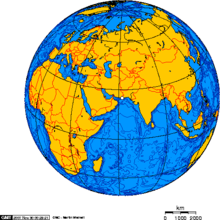
Gwadar's location and history have given it a unique blend of cultures. The Arabic influence upon Gwadar is strong as a consequence of the Omani era and its close proximity to the Arabian peninsula.[29] The Omani legacy is also evident in the Pakistanis of East African ancestry tracing their lineage to Afro-Arabs and Zanji slaves,[33] who settled in the town during Omani rule. Remnants of Oman era buildings can also be found in the city.
Strategic importance
The port of Gwadar can provide China a Listening Post to Observe the Indian naval activities around the Persian Gulf and Gulf of Aden. Central Asia and South Asia, encompassing the Caspian Region, Central Asian republics, Afghanistan and Iran, and the energy-rich ‘lake’ called the Caspian Sea, is a significant region because of its huge monetary prospective and geographically vital positioning, which has formed the region as a centre piece in the international arena.[34] Iran has also declared support for the development of Gwadar and its port.[35]
Economy
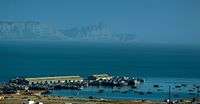
Gwadar's economy has, in the past, been dependent mostly on fishing. Its economy, however, is undergoing rapid transformation as a small fishing village is being transformed into a major port city of Pakistan with improved communication links with the rest of Pakistan. In 1993, the Government of Pakistan commenced a feasibility study for the construction of a deep-sea port at Gwadar. On 22 March 2002, the Government of Pakistan began construction of Gwadar Port, a modern deep-sea port, the first phase of which was completed in December 2005 and the second in March 2007. Gwadar Port became fully operational in December 2009. The 1400 km Trans-Afghan Gas Pipeline (TAP) from Turkmenistan to Gwadar (Pakistan), a long-dormant project that would pump Turkmen natural gas to markets in South Asia, may finally be poised to begin at a cost of $3 billion.
Gwadar Free Zone
The construction on a $2 billion 10-square kilometre tax exempt industrial zone began on 20 June 2016.[36] The zone includes a 300MW plant exclusive for the industrial zone.[37]
Gwadar Port
China has a great strategic interest in Gwadar. In 2013, the state-owned China Overseas Port Holdings Limited acquired Gwadar Port.[38] The port is strategically important for China as sixty percent of China's oil comes from the Persian Gulf by ships traveling over 16,000 km (9,900 mi) in two to three months, confronting pirates, bad weather, political rivals, and other risks up to its only commercial port, Shanghai. Gwadar will reduce the distance to a mere 5,000 km (3,100 mi) and also serve round the year.[39]
China has been instrumental in the design of the project. China is providing approximately 80% of the cost of the port in the shape of grants and soft loans. Over 500 Chinese workers have worked on the project on a 24-hour basis to complete the port setup. There are still a large number of Chinese workers and engineers working on the project. China is setting up a dry port at the Pakistan–China border to take advantage of a shorter route to sea through Gwadar. China paid US$360 million to Pakistan for expansion and an upgrade for all weather trafficability of Karakoram Highway linking Pakistan with China. The contract has been awarded to Frontier Works Organization, who has also started the project. Feasibility and engineering studies to connect China with Gwadar through a pipeline and railway track have already begun.
China is heavily dependent on Persian Gulf oil which passes through the Strait of Malacca all the way through the Indian and Pacific Oceans. Once the oil reaches China's east coast ports, it is transported thousands of kilometres inland to western China. The Gwadar port-Karakoram Highway (KKH) route is sometimes said to be safer, cheaper and shorter than transporting the oil by ocean tanker. However, research suggests that transporting oil by roadways from Gwadar to China would be very expensive, would encounter numerous logistical difficulties such as mountainous terrain, earthquakes, disputes with India, and potential terrorist attacks, and would barely make any impact on China's overall energy security,[40] though Pakistan intends to build an oil pipeline to northern Pakistan that may allay much of these concerns.
Chinese goods flowing in the opposite direction may be able to find an easier, shorter and secure route to the Middle East. The city is also being developed as an export processing zone for foreign companies to manufacture in Gwadar before exporting to various countries in the region. The Government of Pakistan has committed to providing a base to China in Gwadar with the intention of helping secure the area.[41]
Although some analysts claim that China intends to establish a naval presence at Gwadar, others argue that China will be cautious about such a development. A Chinese military presence in Gwadar may provoke a significant reaction from both the United States and India.[42]
New Gwadar International Airport
Due to the Chinese interest in the Gwadar port, Pakistan believes that Gwadar will become a regional hub, Prime Minister Imran Khan has laid down the foundation stone for the New Gwadar International Airport (NGIAP) at Gwadar on 29 March 2019.[43][44] New Gwadar international airport is located in Gurandani which is around 26 km (16 mi) northeast of Gwadar city in Balochistan province. It is expected to cost $246 million with an area of 1,700 ha (4,300 acres) and it will be able to handle big aircraft such as the A380.[25] The new airport will cater to domestic and international flights and will have open skies policy.
It will be a Greenfield airport with a cargo terminal handling capacity of 30,000 tonnes a year. It will have a single runway of 3,658 m (12,001 ft) length and width of 75 m (246 ft) to accommodate wide body aircraft, however an option to build a 2nd runway in future is also feasible.[45] CAA Pakistan has awarded the design and construction contract to the China Communications Construction Company (CCCC), It is expected to be completed in 2022.[46]
See also
- Gwadar International Airport
- Gwadar Port
- Islamabad
- General Headquarters (GHQ)
- Pakistan Government
- Feroz Khan Noon, Viqar-un-Nisa Noon
| Wikimedia Commons has media related to Gwadar. |
References
- "POPULATION AND HOUSEHOLD DETAIL FROM BLOCK TO DISTRICT LEVEL" (PDF). GWADAR_BLOCKWISE.pdf. Pakistan Bureau of Statistics. Retrieved 4 May 2020.
- Serim (18 May 2017). "Gwadar: the Sultan's Possession". www.qdl.qa. Retrieved 26 December 2019.
- Gwadar port: ‘history-making milestones’ -DAWN – Business; 14 April 2008
- Mathias, Hartpence (15 July 2011). "The Economic Dimension of Sino-Pakistan Relations: An Overview": 581–589. Cite journal requires
|journal=(help) - Walsh, Declan (31 January 2013). "Chinese Company Will Run Strategic Pakistani Port". New York Times. Retrieved 22 June 2016.
China paid for 75 percent of the $248 million construction costs,
- "China set to run Gwadar port as Singapore quits". Asia Times. 5 September 2012. Retrieved 23 June 2016.
- Aneja, Atul (18 April 2015). "Xi comes calling to Pakistan, bearing gifts worth $46 billion". The Hindu. Retrieved 23 April 2015.
- Hussain, Tom (19 April 2015). "China's Xi in Pakistan to cement huge infrastructure projects, submarine sales". McClatchy News. Islamabad: mcclatchydc.
- Saran, Shyam (10 September 2015). "What China's One Belt and One Road Strategy Means for India, Asia and the World". The Wire (India). Archived from the original on 18 November 2015. Retrieved 6 December 2015.
- See list of projects: List of projects $230million for Gwadar Airport, $114m desalination plant, $35m for special economic zone infrastructure, $360m for coal plant, $140m for Eastbay Expressway, $100m for hospital, $130m for breakwaters, $27m for dredging. Sum of figures = $1.153 billion
- "Industrial potential: Deep sea port in Gwadar would turn things around". The Express Tribune. 17 March 2016. Retrieved 9 April 2016.
- "China to build $2.5 billion worth LNG terminal, gas pipeline in Pakistan". Deccan Chronicle. 10 January 2016. Retrieved 22 June 2016.
- "Construction of industrial free zone in Gwadar begins". Express Tribune. Retrieved 21 June 2016.
Gwadar Port Authority (GPA), Chairman Dostain Khan Jamaldini said that the construction of Gwadar Free Zone is underway at a cost of US $2 billion.
- Li, Yan. "Groundwork laid for China-Pakistan FTZ". ECNS. Retrieved 6 December 2015.
- "Short term consultancy required for study and preparation of PC1 document for expropriation and resettlement of Old Town Gwadar". Gwadar Development Authority. Retrieved 6 October 2016.
- Pakistan & Gulf Economist. Economist Publications. 2003.
- Jona Lendering, Livius.org. "Gedrosia". Archived from the original on 24 September 2013. Retrieved 6 November 2006.
- "Medieval Sourcebook: Sidi Ali Reis (16th Century CE): Mirat ul Memalik (The Mirror of Countries), 1557 CE". Fordham.edu. Archived from the original on 10 March 2014. Retrieved 20 November 2013.
- "GwÄdar – Imperial Gazetteer of India". p. 415. Archived from the original on 10 May 2013. Retrieved 20 November 2013.
- Dott. Beatrice Nicolini, Oman Studies Centre. "International trade networks: The Omani Enclave of Gwadar". Archived from the original on 8 April 2014. Retrieved 6 November 2006.
- Ahmad, Azhar (5 May 2013). "Unravelling Gwadar town". The Frontier Post Voice of the Federation. Archived from the original on 29 September 2013. Retrieved 5 May 2013.
- "Who do we thank for Gwadar?". Daily Times. Pakistan. 23 May 2018. Retrieved 21 July 2020.
- "Countries and territories of the world". Retrieved 30 July 2018.
- "Gwadar Development Authority". GDA. Archived from the original on 20 October 2013. Retrieved 20 November 2013.
- "Pakistan's Gwadar International Airport will be the largest in the country". gulfnews.com. Retrieved 22 April 2019.
- Persian Gulf Pilot: Comprising the Persian Gulf, the Gulf of Omán and the Makrán Coast. Pilot Guides. 1920. Retrieved 23 June 2016.
- Ali, Naziha Syed (27 April 2014). "Gwadar: on the cusp of greatness?". www.dawn.com. Retrieved 18 June 2016.
- "Pakistan Hands Over Development of Gwadar Port to China". www.cacianalyst.org.
- "Gwadar Industrial Estates Development Authority » About Gawadar". gieda.gov.pk. Archived from the original on 27 March 2018. Retrieved 23 October 2017.
- Archived 13 June 2010 at the Wayback Machine
- Archived 29 August 2009 at the Wayback Machine
- http://121.52.153.178:8080/xmlui/bitstream/handle/123456789/14822/Census%201998%20Gwadar.PDF?sequence=1&isAllowed=y
- "Gwadar's Accession to Pakistan". Pakistan Defence. Retrieved 28 August 2017.
- "Strategic Importance of Gwadar Port" (PDF). Pu.edu.pk. Retrieved 20 November 2013.
- Zafar, Mohammad. "Allaying fears: Iran doesn't disfavour Gwadar port, says top aide – The Express Tribune". Tribune.com.pk. Archived from the original on 27 September 2013. Retrieved 20 November 2013.
- "Construction of industrial free zone in Gwadar begins – The Express Tribune". The Express Tribune. 20 June 2016. Retrieved 20 June 2016.
- "Dailytimes | Gwadar Port to create over 40,000 job opportunities". dailytimes.com.pk. Retrieved 20 June 2016.
- AFP (18 February 2013). "China acquires potential naval base in Pakistan". Manila Times. Archived from the original on 21 February 2013. Retrieved 19 February 2013.
- "Strategic Gwadar in China's hands". Saudi Gazette. 28 February 2013. Archived from the original on 7 February 2015. Retrieved 20 November 2013.
- Garlick, Jeremy (2018). "Deconstructing the China-Pakistan Economic Corridor: pipe dreams versus geopolitical realities". Journal of Contemporary China. 27 (112): 519–533. doi:10.1080/10670564.2018.1433483.
- "Chinese Interest and Investment | Gwadar Private Scheme Information Center". Gwadarprivatescheme.wordpress.com. Archived from the original on 2 January 2014. Retrieved 20 November 2013.
- Brewster, David. "Beyond the String of Pearls: Is there really a Security Dilemma in the Indian Ocean?. Retrieved 11 August 2014".
- "PM Imran lays foundation stone of new Gwadar international airport". The Nation. 29 March 2019. Retrieved 22 April 2019.
- "Development of Gwadar will benefit entire world: PM". www.radio.gov.pk. Retrieved 22 April 2019.
- https://www.caapakistan.com.pk/upload/News/pdf/29032019-1.pdf
- "New Gwadar International Airport, Pakistan". Airport Technology. Retrieved 22 April 2019.
